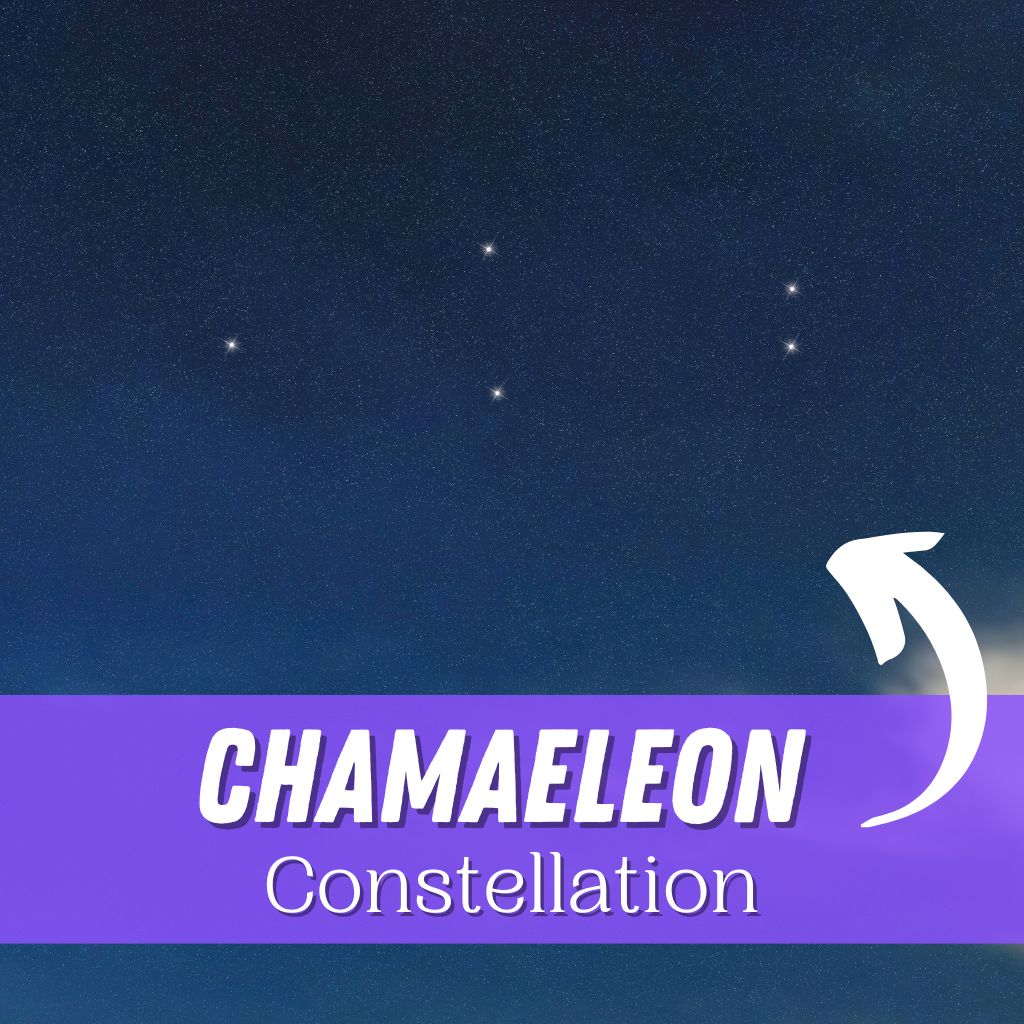This site contains affiliate links to products. I may receive a commission for purchases made through these links.
The Chamaeleon constellation, named after the small reptile it resembles, is a fascinating and lesser-known constellation in the southern celestial hemisphere.
Spanning an area of the night sky, it is a constellation that captures the imagination of astronomers.
In this article, we will take a deep dive into the Chamaeleon constellation, exploring its location, notable stars, and its intriguing legends.
What is the location of the Chamaeleon constellation?
The Chamaeleon constellation can be found in the southern celestial hemisphere. It is situated near the South Celestial Pole, making it predominantly visible from latitudes below the equator.
The constellation occupies an area between the constellations Musca, Octans, Carina, Volans, and Mensa.
Its location in the southern skies gives observers in the southern hemisphere a unique opportunity to admire and study this elusive and captivating constellation.
How to identify the Constellation Chamaeleon

Identifying the Chamaeleon constellation in the night sky can be a rewarding experience.
While it may not be as prominent as some of the more well-known constellations, there are several key steps to help you locate it.
They are as follows:
Locate the South Celestial Pole
Since the Chamaeleon constellation is located near the South Celestial Pole, start by finding this reference point in the southern sky. It will serve as a guide to orient yourself.
Look for distinctive stars
Chamaeleon is a small constellation with a few notable stars that can help in identification. One such star is Alpha Chamaeleontis (α Cha). It can serve as an anchor point when trying to locate Chamaeleon.
Trace the constellation’s shape
Chamaeleon is often depicted as a small lizard or chameleon in the sky. While its shape may not be immediately obvious, you can use star charts or smartphone apps to trace the pattern formed by its stars.
Look for the outline or connect the dots to visualize the constellation’s figure.
Dark skies and patience
It’s important to choose a location with minimal light pollution to enhance visibility. Allow your eyes to adjust to the darkness and be patient in identifying the fainter stars that form the constellation.
Remember, it may take some time and practice to become familiar with identifying the Chamaeleon constellation. Don’t be discouraged if you don’t spot it right away.
With persistence and a bit of stargazing, you’ll soon become adept at recognizing this unique and intriguing constellation in the southern skies.
Seasonal visibility and best viewing times of the Chamaeleon constellation
The Chamaeleon constellation has varying visibility throughout the year, depending on the season and the observer’s location.
Here are some general guidelines on its seasonal visibility and the best times to observe it:
Southern Hemisphere visibility
The Chamaeleon constellation is primarily visible from latitudes below the equator, making it more prominent and easily observable from countries in the southern hemisphere, such as Australia, South Africa, and parts of South America.
Autumn and winter
In the southern hemisphere, the Chamaeleon constellation is generally more visible during the autumn and winter months (March to August). During this time, it rises higher in the sky and remains above the horizon for longer periods, providing ample opportunities for observation.
Dark, moonless nights
To enhance your chances of observing the Chamaeleon constellation, it is best to choose nights with minimal light pollution and little interference from the Moon.
Dark, moonless nights provide optimal conditions for spotting the fainter stars and features of the constellation.
Clear weather
Like any stargazing activity, clear and cloudless skies are ideal for observing the Chamaeleon constellation.
Be sure to check the weather forecast before your observation session to ensure optimal viewing conditions.
Reference guides and apps
Utilize star charts, astronomy apps, or online resources to help you locate and identify the Chamaeleon constellation. These tools can provide valuable information about its position in the sky at specific times and aid in identifying its key stars.
How many stars are in the Chamaeleon constellation?
The Chamaeleon constellation contains numerous stars, but it is important to note that not all of them are visible to the naked eye.
In total, there are around 68 stars in the constellation that have been identified and cataloged.
Major stars in the Chamaeleon constellation
Some of the major stars in the Chamaeleon constellation include:
Alpha Chamaeleontis (α Cha)
Alpha Chamaeleontis is the brightest star in the Chamaeleon constellation. It is a binary star system consisting of two stars orbiting each other.
Beta Chamaeleontis (β Cha)
Beta Chamaeleontis is another notable star in the constellation. It is a spectroscopic binary star, meaning the presence of two stars is detected through changes in the spectral lines.
Gamma Chamaeleontis (γ Cha)
Gamma Chamaeleontis is a binary star system with two stars in close proximity to each other.
δ1 Chamaeleontis (Delta-1 Chamaeleontis)
Delta-1 Chamaeleontis, also known as δ^1 Cha, is a binary star system located in the Chamaeleon constellation. It consists of two stars that orbit each other.
The primary star is a young, blue-white dwarf with a spectral type of B9V. The secondary star is a smaller, fainter companion. Delta-1 Chamaeleontis is approximately 385 light years from Earth.
HD 63454
HD 63454 is a single star located in the Chamaeleon constellation. It is a yellow-white dwarf with a spectral type of F6V.
This star is relatively young, and it is still in the process of evolving. HD 63454 is situated approximately 186 light-years away from Earth.
ε Chamaeleontis (Epsilon Chamaeleontis)
Epsilon Chamaeleontis, also known as ε Cha, is a binary star system in the Chamaeleon constellation. It is one of the member stars residing within the Chamaeleon constellation. The primary star is a yellow-white dwarf with a spectral type of F8V.
The secondary star is a red dwarf companion. Epsilon Chamaeleontis is located approximately 73 light-years away from Earth.
R Chamaeleontis
R Chamaeleontis is a variable star in the Chamaeleon constellation. It belongs to the class of Mira variables, which are pulsating stars that undergo regular changes in brightness.
R Chamaeleontis is a red giant with a spectral type of M7IIIe. Its variability makes it an interesting object of study for astronomers.
CT Chamaeleontis
CT Chamaeleontis is a young star located in the Chamaeleon constellation. It is classified as a T Tauri star, which is a type of pre-main sequence star.
CT Chamaeleontis is known for its active accretion disk, where the material falls onto the star, indicating ongoing star formation processes.
Explore the celestial dance of Tauri stars within the Chamaeleon constellation, where these luminous celestial bodies illuminate the night sky with their captivating presence.
What are the bright stars of the Chamaeleon constellation?
The Chamaeleon constellation does not have many bright stars visible to the naked eye.
However, some of the relatively brighter stars in the constellation include:
- Alpha Chamaeleontis
- Beta Chamaeleontis
- Gamma Chamaeleontis
- Delta Chamaeleontis
What is the Chamaeleon constellation’s brightest star?
The brightest star in the Chamaeleon constellation is Alpha Chamaeleontis (α Cha). It shines as the dominant bright star in the constellation and serves as a reference point for identifying the Chamaeleon constellation in the night sky.
Deep-sky objects within the Chamaeleon constellation
The Chamaeleon constellation is home to several notable deep sky objects, including:
NGC 3195
A planetary nebula located in the Chamaeleon constellation showcasing a colorful and intricate structure of expelled stellar material.
NGC 3114
An open star cluster nestled within Chamaeleon, composed of young, hot stars illuminating the cosmic landscape.
IC 2631
A reflection nebula, also known as the “Running Chicken Nebula,” exhibiting a distinctive shape resembling a running bird.
Eta Chamaeleontis Cluster
An open cluster consisting of young stars scattered across a relatively small area of the Chamaeleon constellation.
Chamaeleon constellation fun facts
Here are some fun facts about the Chamaeleon constellation:
Is the Chamaeleon constellation elusive?
The Chamaeleon constellation is known for its faint stars and relatively obscure location, making it a challenge to spot in the night sky.
Is the Chamaeleon constellation small?
The Chamaeleon constellation is relatively small, occupying an area of about 131 square degrees.
What reptile is the Chamaeleon constellation named after?
Chamaeleon was named after the small reptile known as the chameleon due to its resemblance to the shape of the constellation.
When was the Chamaeleon constellation officially named?
European astronomers officially recognized and named the Chamaeleon constellation in the 16th century.
Is the Chamaeleon constellation associated with stellar nurseries?
Chamaeleon is known for its association with the formation of stars, as it contains regions of ongoing star formation and young stellar clusters.
Does the Chamaeleon constellation have Messier objects?
Unlike some other constellations, Chamaeleon does not contain any objects listed in the Messier catalog. The Messier catalog is a collection of astronomical objects such as galaxies, nebulae, and star clusters that are commonly observed and studied.
What is the Chamaeleon constellation story?
The Chamaeleon constellation does not have a prominent mythology or story associated with it in ancient cultures.
It was officially recognized and named by European astronomers in the late 16th century based on its resemblance to the small reptile, the chameleon.
What does the Chamaeleon constellation symbolize?
The Chamaeleon constellation does not have ancient mythological connections, so it does not hold symbolic significance like some other constellations.
What is the constellation Chamaeleon called in Latin?
“Chamaeleontis” is the Latin genetive name of the Chamaeleon constellation. This term is employed to designate several prominent stars within this constellation according to the Bayer or Flamsteed star naming system.
How old is the Chamaeleon constellation?
The Chamaeleon constellation, like other constellations, does not have an age in the traditional sense. It is a configuration of stars that appears from our perspective on Earth and has likely existed for millions of years.
Who discovered the Chamaeleon constellation?
European astronomers officially recognized and named the Chamaeleon constellation in the late 16th century.
Chamaeleon in Greek mythology
In Greek mythology, the Chamaeleon constellation does not have a well-known myth or legend associated with it.
Unlike many other constellations that were named after mythical creatures or figures, the Chamaeleon constellation was not part of the ancient Greek constellation system.
Can you view the Chamaeleon constellation with a telescope?
The Chamaeleon constellation can be viewed with a telescope. While it may not be as well-known or prominent as some other constellations, it still contains several interesting deep-sky objects that can be observed using a telescope.
With a telescope, you can explore the intricate details of the Chamaeleon constellation and observe various celestial objects within it.
Here are some recommended telescopes for viewing the Chamaeleon Constellation
Celestron NexStar 6SE Telescope
The Celestron NexStar 6SE is a powerful and versatile telescope that is well-suited for observing the Chamaeleon constellation.
With its 6-inch aperture and advanced features like a computerized mount with motorized tracking, it allows for precise and convenient sky exploration.
The telescope’s high-quality optics provide clear and detailed views of the celestial objects within the Chamaeleon constellation, revealing the intricacies of star clusters and nebulae.
Its portable design makes it easy to transport to dark sky locations, enhancing the viewing experience of this elusive constellation.
You may also like:
Orion SkyQuest XT8 Classic Dobsonian Telescope
The Orion SkyQuest XT8 Classic Dobsonian Telescope is a popular choice for deep-sky observation, including the Chamaeleon constellation.
With its large 8-inch aperture and sturdy Dobsonian mount, this telescope offers impressive light-gathering capabilities and stability for viewing faint celestial objects.
Its user-friendly design makes it suitable for beginners and experienced astronomers alike.
Meade LX90-ACF 10″ Schmidt-Cassegrain Telescope
The Meade LX90-ACF 10″ Schmidt-Cassegrain Telescope is a professional-grade instrument that delivers exceptional views of celestial objects, including those in the Chamaeleon constellation.
Its large 10-inch aperture and advanced ACF optics provide sharp and high-resolution images.
The telescope’s computerized GoTo system and tracking capabilities enable precise alignment and automatic tracking of objects in the sky, making it easier to locate and observe specific targets within the Chamaeleon constellation.
Takeaway: Immerse yourself in the wonders of the Chamaeleon constellation for an unforgettable stargazing adventure!
Journey into the depths of the Chamaeleon cloud complex, an enigmatic cosmic formation that blankets the constellation.
The Chamaeleon constellation presents a fascinating celestial realm for stargazers and astronomy enthusiasts.
While its mythology may not be well-known, its allure lies in its elusive nature and the opportunity to explore lesser-known regions of the night sky.
From observing deep-sky objects like dark nebulae to discovering star clusters and galaxies, the Chamaeleon constellation offers a captivating journey into the beauty and mysteries of our universe.
You may also like:







